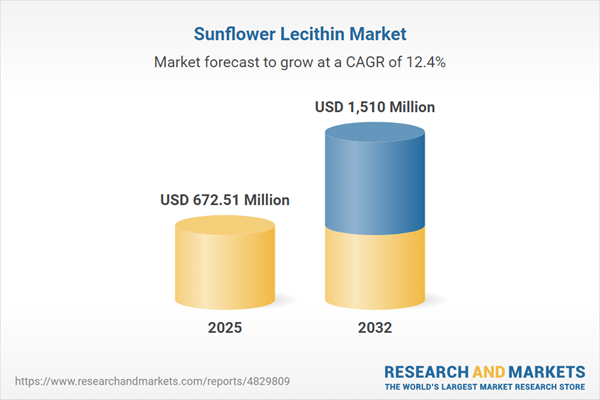Speak directly to the analyst to clarify any post sales queries you may have.
The sunflower lecithin market is undergoing significant change as senior decision-makers seek cleaner, traceable ingredients to meet evolving regulatory and consumer expectations. Organizations in diverse industries are prioritizing advanced sourcing, compliance, and technology-driven initiatives to strengthen their supply chains and achieve resilient growth.
Market Snapshot: Sunflower Lecithin Market Size and Growth
The sunflower lecithin market is forecast to post substantial expansion from 2024 through 2025 and sustain a double-digit compound annual growth rate through 2032. Growth is fueled by organizations adopting plant-based emulsifiers to enhance product performance and comply with clean-label requirements. Increasing demand for non-GMO, allergen-free, and safe alternatives is positioning sunflower lecithin as a versatile ingredient across major consumer applications, supporting its acceptance in both established and emerging regions.
Scope & Segmentation of the Sunflower Lecithin Market
This in-depth report empowers leaders with actionable intelligence on the drivers reshaping sunflower lecithin demand, technology, and competitive strategies. Segmentation analysis informs targeted decision-making, enabling businesses to refine offerings and regional approaches for a dynamic global landscape.
- Form Types: Liquid forms, including high purity and standard, as well as Powder options such as spray dried and vacuum dried, address varying manufacturing needs and formulation efficiencies.
- Nature: Conventional and Organic varieties are profiled, with the organic segment highlighted for its contribution to certification and consumer trust initiatives.
- Grades: Detailed coverage of Cosmetic, Food, Industrial, and Pharmaceutical grades provides insight into technical and regulatory standards across key sectors.
- Applications: Sunflower lecithin’s use spans animal feed, cosmetics, personal care, pharmaceuticals, and food and beverage categories, supporting a breadth of end-use innovation.
- Distribution Channels: Both offline (direct sales, distributors) and online (corporate websites, third-party e-commerce) pathways are evaluated for their roles in supply flexibility and efficient customer reach.
- Regional Coverage: The Americas, Europe, the Middle East & Africa, and Asia-Pacific are assessed, each with unique regulatory environments and evolving consumption patterns that inform localized strategy.
- Technology Focus: Technologies such as cold pressing, membrane separation, and process automation are examined for their impact on efficiency, purity, and differentiation in product offerings.
- Leading Players: Key companies including Archer Daniels Midland Company, Cargill, Incorporated, Bunge Limited, Lecico GmbH & Co. KG, Lipoid GmbH, Lucas Meyer Cosmetics Inc., Lekithos Inc., Fismer Lecithin GmbH, Buxtrade GmbH, and Caldic B.V. demonstrate the strategic roles of established global and regional participants.
Key Takeaways for Senior Decision-Makers
- Sunflower lecithin stands out as a non-GMO and non-allergenic ingredient, enabling manufacturers to replace synthetic and animal-based emulsifiers in response to industry and consumer shifts.
- Investments in cold pressing and membrane separation are improving process efficiency and resulting in higher product purity, supporting quality-focused manufacturing objectives.
- Robust traceability measures, including blockchain-enabled documentation, are enhancing compliance and fortifying clean-label claims for downstream customers.
- Sustainability initiatives such as circular economy programs and by-product valorization reduce material waste and align with corporate environmental objectives.
- Complex regulatory frameworks, particularly across Europe, require meticulous sourcing and certification approaches for effective premium market positioning.
- Ongoing R&D investment and collaborative initiatives help expand use cases in pharmaceuticals and functional foods, providing options for tailored product innovation.
2025 Tariff Impact: Supply Chain and Cost Management
Recently introduced tariffs in the United States for 2025 are prompting both global and local market players to reassess sourcing, procurement, and logistics frameworks. Companies are diversifying suppliers, optimizing ingredient inputs, and developing alternate trade corridors to manage risk. These adjustments support cost control and quality assurance during procurement and manufacturing, reinforcing supply chain resilience amid changing trade dynamics.
Methodology & Data Sources
Research for this analysis integrates secondary data with expert interviews across roles such as agronomists, process engineers, R&D leaders, and regulatory professionals. Triangulation with scenario analysis validates findings, ensuring reliability for current and emerging sunflower lecithin market trends and supply chain impacts.
Why This Report Matters
- Gain actionable insights into evolving supply chain structures, new technology applications, and regulatory trends critical for leadership teams navigating the sunflower lecithin market.
- Benchmark strategic procurement and innovation approaches of global market leaders to strengthen your competitive position.
- Enable agile planning and targeted expansion by addressing supply, compliance, and market disruption risks.
Conclusion
This market report delivers the intelligence required for decision-makers to develop effective strategies in the sunflower lecithin industry. Adapt data-driven approaches to stay competitive as clean-label preference and regulatory changes continue to shape the sector.
Additional Product Information:
- Purchase of this report includes 1 year online access with quarterly updates.
- This report can be updated on request. Please contact our Customer Experience team using the Ask a Question widget on our website.
Table of Contents
3. Executive Summary
4. Market Overview
7. Cumulative Impact of Artificial Intelligence 2025
List of Figures
Samples

LOADING...
Companies Mentioned
The key companies profiled in this Sunflower Lecithin market report include:- Archer Daniels Midland Company
- Cargill, Incorporated
- Bunge Limited
- Lecico GmbH & Co. KG
- Lipoid GmbH
- Lucas Meyer Cosmetics Inc.
- Lekithos Inc.
- Fismer Lecithin GmBh
- Buxtrade GmbH
- Caldic B.V.
Table Information
| Report Attribute | Details |
|---|---|
| No. of Pages | 195 |
| Published | October 2025 |
| Forecast Period | 2025 - 2032 |
| Estimated Market Value ( USD | $ 672.51 Million |
| Forecasted Market Value ( USD | $ 1510 Million |
| Compound Annual Growth Rate | 12.3% |
| Regions Covered | Global |
| No. of Companies Mentioned | 11 |









